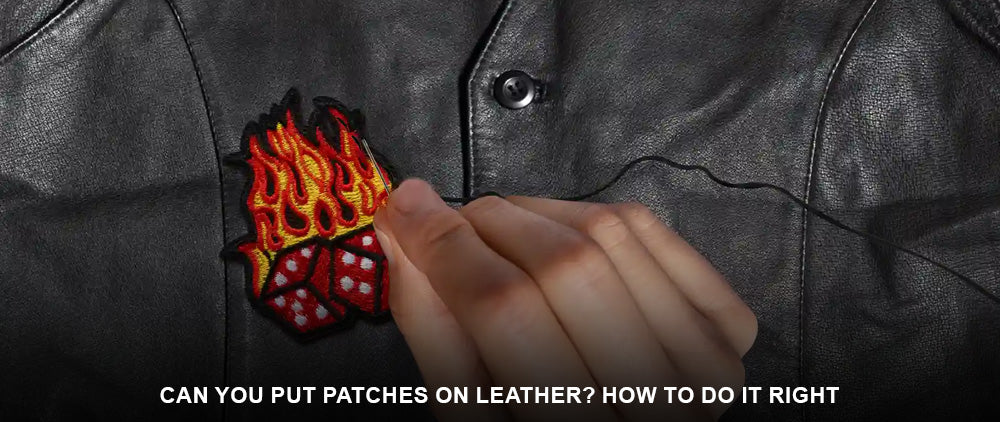For both bikers and fashionistas, patches are more than just ornamental accessories; they are statements of individuality, club affiliation, and even significant life events. But for some, it might also be the way to repair a jacket.
However, can you put patches on a leather jacket? Yes, without a doubt, but only if you do it correctly.
Don't know how to put patches on leather? We are here with all you need to know, along with the aftercare of leather items.

Understanding the Material First
Can You Put Patches on Leather? Before that, you must know the materials.
Leather is a porous, natural material. Although it is strong and flexible, it is also vulnerable to harsh adhesives, pressure, and heat. Patching leather is, therefore, possible, but it's more complicated than patching denim or canvas.
Whether you want men’s leather motorcycle jackets to customize with patches or adorn leather vests that are ideal for patch designs and club logos, applying patches requires selecting the best technique for the leather's finish, thickness, and intended use.
Before You Apply a Patch: Leather Prep Essentials
Before answering how to put patches on a leather jacket, you need to prepare and properly clean your leather jacket or any item.

- Cleaning Your Jacket
To get rid of any residue, oil, or grime, use a high-quality leather cleaner. This will avoid skipped stitches when sewing and enhance adherence for glue or iron-on patches. Before applying patches, you must know all about cleaning your jacket before adding patches.

- Softening Leather
Use a mild heating technique or a leather conditioner to soften a stiff jacket or vest. Softer leather adheres better to glued patches and is easier to pierce with a needle. Learn how to prepare the surface to soften a leather jacket quickly.

- Repair Faux Leather Before Applying Patches
Do you have a fake leather jacket that is peeling or cracking? Prior to applying any patches, restore the surface with filler and pigment. Before using patches, read about repairing faux leather before applying patches.
How to Put Patches on Leather: 3 Expert-Approved Methods
Now, as for the patches methods, there are many you can find. The top 3 ways about how to patch a leather jacket are as follows.

- Sewing Patches on a Leather Jacket
Sewing is the best option for achieving a long-lasting, permanent result.
Can you sew patches on leather? Yes, but you'll require specific equipment:

What do you need for it?
- Glover's needle or leather needle
- The thread that is made of waxed nylon or polyester
- Thimble made of leather
- For stitching holes, a rotary punch or pricking iron is optional.
- Binder clips or masking tape (to hold the patch in place)
Step-by-Step:
- Place the Patch: Use tape or clips to hold it in place. Pins will leave holes, so stay away from them.
- Pre-punch Holes (not required, but advised): To make stitch holes without putting undue strain on the leather, use a rotary punch or pricking iron.
- Take Care When Sewing: For durability, hand-stitch with a saddle stitch. Take care not to pucker the leather by pulling the thread too tightly.
- Secure Tie-Off: For a neat finish, backstitch or knot inside the jacket
For leather vest patches or bikers’ jackets that are exposed to everyday wear or road conditions, this technique is perfect.

- Using Glue for Patches on Leather
In search of a no-sew solution? Then, glue could be the solution. However, any adhesive won't work. Select the best glue for patches on leather, such as:
- Barge All-Purpose Cement
- Fiebing’s Leathercraft Cement
- Aleene’s Leather & Suede Glue
How to Put a Patch on a Leather Jacket Without Sewing:
- Roughen the Leather: To improve the bonding surface, lightly sand the area with fine-grit sandpaper.
- Apply Glue: Cover the leather surface and the patch with a thin, even layer.
- Press Firmly: Apply pressure with a book or roller. Allow it to cure for 24 to 48 hours.
- If Necessary, Reinforce: Consider sewing around the glued edges later for high-mobility areas, such as the shoulders and elbows.
Gluing is perfect for temporary or decorative leather jacket patches because it is less intrusive than sewing.

- Iron On Patches for Leather Jackets: Are They Safe?
The ease of use of iron-on techniques may be alluring, but exercise caution. Leather is prone to scorching and is heat-sensitive. The majority of iron-on patches for leather jackets need protective barriers and low heat.

How to Attach Patches to Leather with an Iron:
- Place a pressing cloth between the patch and the iron.
- Iron on low (wool or silk) setting without steam.
- At 10-second intervals, press.
- For 30 to 60 minutes, let it cool under a weight.
Note: These techniques are also some ways of extending jacket life with proper care and patchwork. However, for full-grain leather or thick motorcycle gear, this technique is not advised.

Aftercare Patched Leather: Maintenance Tips
The quality of the leather a patch is placed on determines its quality. Observe these care instructions to safeguard your investment:
- To keep the leather in your jacket supple, condition it regularly.
- Do not soak the patch area, especially if it is glued.
- To avoid warping, store in a cool, dry location.
- Only use pH-balanced leather cleaners to spot-clean patched areas.
With proper maintenance and care, you can prolong the life of your jacket and ensure its durability and style. As for patching safety gear like motorcycle jackets, a few steps differ depending on the gear.
Conclusion
So, can you put patches on leather? Absolutely—if done right. Whether you're repairing wear and tear or adding a personal touch, patches give leather jackets a new life.
At Daniel Smart MFG, we offer the highest-quality biker gear built for patching, style, and durability. If you're looking for a biker jacket with patches or want to create a bold statement, our products are made to last. And if you’re considering a different style, our leather vests are perfect for patch designs and club logos.
Invest in the right gear, patch it properly, and ride in style.
FAQs
- How do you attach patches to leather?
You can sew, glue, or use heat-activated adhesives to affix patches to leather. While gluing is a quicker option, sewing offers a more permanent and long-lasting bond, and heat-activated adhesives work well for certain patches.
- How do you attach patches to leather without sewing?
After stabilizing the patch with safety pins on opposite edges and applying a little fabric glue at the back, you can "slip stitch" the patch's edges.
- What is the best glue to attach patches to leather?
Dispersion or solvent adhesives based on polyurethane or polychloroprene are typically used to bond leather. Although the heat activation method can also be used, the contact bonding method is typically used to apply the latter.
- Can you iron-on patches to fake leather?
Yes. Cover the patch with a piece of thin cloth or a pressing cloth. After the iron has reached the proper temperature, gently press the patch through the cloth. Keep the iron moving while applying constant pressure for 20 to 30 seconds. This guarantees that the patch will stick firmly without melting the imitation leather.
- What kind of glue can I use to put on iron-on patches to go on a leather vest?
The majority of iron-on patches have a heat-activated adhesive backing. Iron-on patches can be attached with fabric glue, though, if the adhesive has worn off or if you want a more secure fit.


